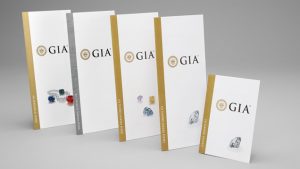As many of our clients know, almost all of the Lauren B diamond inventory contains GIA certified diamonds. We are often asked how other grading laboratories stand up to GIA, and the answer is simple: with a world-renown reputation and a strict benchmark for grading, you can rest assured that your GIA diamond is worth the investment!
The Standards are High..
Diamonds certified by the Gemological Institute of America are subjected to various tests that yield specific results. For example, clarity is determined at 10x magnification to isolate any imperfections within the diamond, even if they are not seen to the naked eye. They consider not only the color and size of inclusions, but also their location within the diamond and how many of them there are. While it is a tedious process, it is helpful to distinguish one clarity grade from another (even if they are very close!) so that you know what you are buying.
For color grades, diamonds are compared with other diamonds that have already been color graded to establish the degree of warmth (or yellow tinge) present within the stone. Even the cut grades are determined by the exact proportions of the diamond as relevant to the carat weight, as well as the degree from which they deviate from the “ideal” standards.
All of these factors work together to help calculate the value of diamonds within specific ranges so that they remain as consistent as possible. Many other laboratories have less strict standards, so it is more difficult to ascertain discrepancies between ratings. Every diamond is evaluated by several licensed gemologists to ensure the most accurate results – this attention to detail is crucial, as it leaves little room for error in the grading process.

You’ve Probably Heard Of Them..
GIA is internationally known, and the most widely-accepted grading laboratory in the world. This is important because it is very easy for jewelers to understand where a diamond ranks in terms of cost and demand if it is GIA certified. For the consumer, GIA diamonds are the best possible investment because their popularity helps to sustain the value for years to come.
They are Easy to Identify..
Despite common belief, not all diamonds are certified – and aside from general paperwork and relative appearance, it can be difficult to distinguish one loose diamond from another. GIA will now laser-inscribe the diamonds they certify to ensure that your report number matches the exact graded diamond. This is helpful if you are skeptical about purchasing or setting a diamond with complete transparency – especially with many online retailers on the market!
They Started It!
Let’s not forget where it all began.. GIA created the original color and clarity scales that many other labs have since adopted and adjusted to reflect their own basis of comparison. For example, a diamond that might rate as “H” color, or near colorless on the GIA scale may be deemed “F” color by another laboratory. This type of “over-grading” can confuse clients seeking a specific look for their diamond, as it lacks consistency and leaves assumed grades wide open to interpretation.

**Fun Facts**
- In the early days of diamond grading, there was a brief stint in which white diamonds were color-graded A-Z. This was deemed too confusing for both jewelers and clients, who thought that the system equated the educational standard of A for Excellent, etc., as opposed to the actual measure of color or warmth. GIA created and implemented the D-Z range to leave out those assumed grades and begin with an entirely new unit of measure.
- GIA is the only laboratory that is also a school! People from all over the world come to GIA in New York, NY or Carlsbad, CA to become certified gemologists- the very people who grade the gemstones our clients purchase every day!
For more information on diamond education, read here!
To connect with a Lauren B. Diamond Adviser regarding your own loose diamond needs, submit an inquiry here!
